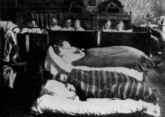| |
Sexual Reform: Social and Sexual Distress |
| |
At the end of the nineteenth century, rapid industrialization and what was regarded as the threatening spectre of proletarization and pauperization led the lower middle and middle classes, in particular, to respond with efforts at reform. Unlike the organized working class, which was struggling for a change in the relationships of production, they sought to alleviate social misery by means of changes in the immediate social environment. The spectrum ranged from those who propagated conservative values and romantic notions of nature to groups committed to a new image of woman. The movements for sexual reform sought to eliminate social distress among the population by reforming legislation on marriage and sexuality. They addressed unwanted pregnancy, the spread of venereal diseases, the State regulation of female sexuality - which left women with only two options, marriage or prostitution - etc. The reformers included many medical doctors from poor neighborhoods who were confronted on a daily basis with working-class women's problems of unwanted pregnancy and too many mouths to feed. By using the political slogan "sexual distress", the sexual reform movements sought to ally themselves with the labour movement's struggle against "social distress".
In their fight against the various forms of "sexual distress", the sexual reform movements supported the need for the scientific investigation of "sexual problems" in order to counter prejudice and traditional values with scientific arguments.
further picture examples:
1
2
3
4 |
|
next text > |
|
|




